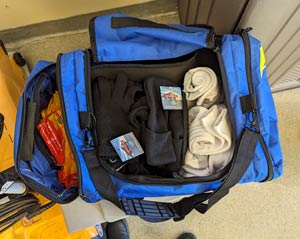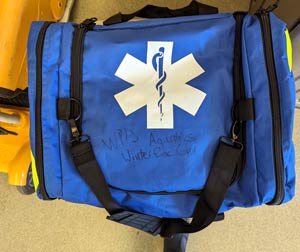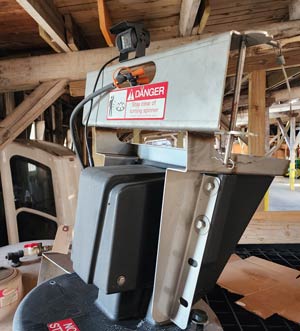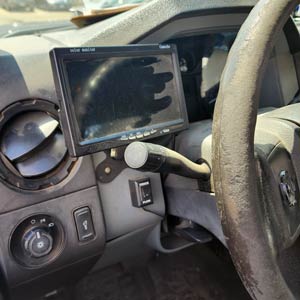
Innovative Ideas Help Agencies Keep Patrons and Employees Safe
Winter brings exceptional challenges to member agencies, and those challenges require exceptional solutions. Here are two different, innovative — and Risk Management Grant and Recognition award-winning — solutions to challenges that can only arise in winter. In one, a false alarm at the aquatics center one snowy January revealed a serious risk to patrons; in the other, some new equipment made a typical winter task easier, safer and less costly.
Waukegan Park District
According to Tony Strack, Recreation Supervisor of Aquatics, it was a fairly cold, windy January afternoon in 2022 when the fire alarm went off in the aquatic center. “This wasn’t a drill, but luckily there wasn’t a fire either. However, we didn’t know that immediately and had to evacuate everyone.”
 Tanya Brady, Manager of Risk Management, points out that patrons weren’t cooperating with staff in evacuating the facility; they wanted to go back to the locker rooms to change. “Understandably, people didn’t want to go outside in a wet swimsuit in the middle of a Chicago winter without any protection.” Luckily, the agency quickly learned it was a false alarm, and staff offered patrons towels or let them go back to the locker rooms to grab their things. “But that got us thinking,” she adds, “about what we would do if there were a real fire. That’s when being delayed to return to the locker room just isn’t an option.” Tanya Brady, Manager of Risk Management, points out that patrons weren’t cooperating with staff in evacuating the facility; they wanted to go back to the locker rooms to change. “Understandably, people didn’t want to go outside in a wet swimsuit in the middle of a Chicago winter without any protection.” Luckily, the agency quickly learned it was a false alarm, and staff offered patrons towels or let them go back to the locker rooms to grab their things. “But that got us thinking,” she adds, “about what we would do if there were a real fire. That’s when being delayed to return to the locker room just isn’t an option.”
Strack came up with the idea of preparing Aquatic Evacuation Bags with towels, blankets, foot coverings and other items to protect patrons from the winter elements and encourage them to leave quickly. The agency trained aquatic center and front desk staff in how to use and distribute the bags in an emergency.
 There are several risk factors when it comes to evacuating aquatic patrons quickly in the middle of winter, and Brady offers these tips to PDRMA members. There are several risk factors when it comes to evacuating aquatic patrons quickly in the middle of winter, and Brady offers these tips to PDRMA members.
- Give patrons protection, which encourages them to get outside quickly — the fundamental issue when a fire alarm goes off.
- How much protection is enough? Be sure your evacuation bag(s) have enough supplies for your expected patron numbers. Waukegan’s bags can supply up to 20 patrons.
- Try to stock items that won’t expire and are disposable.
- Consider storage options for the evacuation bags. Waukegan stores theirs on the deck, so they don’t have to go anywhere else to get supplies before providing them to people in the pool.
DeKalb Park District
DeKalb’s grant-winning idea — a salt hopper with two cameras that eliminated the need for a driver to get in and out of the truck to check salt levels — solved several ongoing problems with snow and ice removal, and makes backing up safer.
 DeKalb mechanic Kevin Hager explains. “We have about 10 parking lots to salt. It really matters how much snow and ice we have that day. We check our busy locations like SRC and Hopkins to make sure they are good. This all came up after one of our guys backed into a snowbank and broke the spinner. That’s when we knew we needed cameras in the truck, so we added one at the rear and one on top of the salt spreader. Now, when we back up to some of the main entrance doors, the cameras make it very easy to see how close we are to the doors and how far we are throwing the salt.” DeKalb mechanic Kevin Hager explains. “We have about 10 parking lots to salt. It really matters how much snow and ice we have that day. We check our busy locations like SRC and Hopkins to make sure they are good. This all came up after one of our guys backed into a snowbank and broke the spinner. That’s when we knew we needed cameras in the truck, so we added one at the rear and one on top of the salt spreader. Now, when we back up to some of the main entrance doors, the cameras make it very easy to see how close we are to the doors and how far we are throwing the salt.”
 The dual camera system is easy to use, Hager adds. “The cameras come on as soon as you turn on the truck and go off when you turn off the truck. To switch between the hopper and rear cameras, there is a V1/V2 button on the screen to choose which view you want.” The dual camera system is easy to use, Hager adds. “The cameras come on as soon as you turn on the truck and go off when you turn off the truck. To switch between the hopper and rear cameras, there is a V1/V2 button on the screen to choose which view you want.”
Staff gives the system high marks, too. “They say it’s nice not having to climb up in the bed to see how much salt is left in the hopper, and they can see how much salt they are putting down, too,” Hager notes. “We can adjust the amount of salt we put down by seeing how much is coming out of the spreader, which saves us salt — and money — in the long run.”
During the off season, Hager says it’s easy to unplug everything and store it safely in the truck. “I balled up all the wires and put them in a plastic box, tying it to the inside of the rear bumper.”
For more information about all the 2023 Risk Management Grant and Recognition winners, click here.
Wondering About Your Winter Wonderland Liability?
Part of a winter wonderland for PDRMA members is wondering about the extent of their agency liability after a heavy snowfall.
“Your agency has no common law duty to remove natural accumulations of ice and snow. Generally speaking, if you never remove snow, you cannot be sued successfully,” says PDRMA Deputy General Counsel Dustin Fisher. If, however, you begin maintaining snow or ice accumulation, you have a duty to do so competently.
Although you’re not required to remove natural accumulations, you can be held liable for “unnatural accumulations” of ice and snow. “For example, plowing snow into a big pile in your parking lot — the snow on the pile begins to melt in the afternoon sun, and the meltwater refreezes in an area designated for parking. Our law considers that an unnatural accumulation. If you create a snow pile, you must maintain the snow pile, and the meltwater it produces. Once you decide to maintain an area, document your maintenance efforts in detail to counter slip and fall cases.”
What’s natural: Snow, rain, ice, sleet — whatever falls from the sky — and meltwater that refreezes due to regular maintenance, such as ice and slush from salting efforts or the remnants left behind from shoveling or plowing; water that arrived at that particular location through no fault of ours.
What’s not natural: Water directed to that particular location by the property owner. Runoff from roofs, gutters, downspouts, drains and property defects are all potential areas for unnatural accumulations. Fisher notes that meltwater from large snow piles in parking lots (as opposed to sidewalks or entryways) is particularly difficult. Patrons often park right next to the piles (their running cars often causing melt water), the lighting can be inadequate, the grade/slope tends to be worse than that of sidewalks and potholes and cracks often get less attention in a large area like a parking lot, so the meltwater gathers. “Temperature fluctuations mean staff should treat areas near snow piles with the same level of attention as sidewalks,” he adds.
Smart steps: The key, Fisher explains, is a regular inspection schedule. “It identifies hazards and demonstrates your efforts to maintain the area(s). Runoff from the pitch of a roof, downspouts where the water is directed to walking paths and snow piles are particularly important to watch for unnatural accumulations. Once you identify a hazard, you can either take corrective action (remove ice/snow, place salt) or mark areas with signage or cones. Posting warnings and signage in parking lots and on your agency’s website are low-cost and helpful solutions.”
Other tips:
- Consider where you create a snow pile in/around parking lots or intended walkways.
- Adopt and communicate rules to prohibit parking near drains, snow piles and other locations where meltwater flows.
Larger-size salt not only melts the ice and snow but provides a warning to pedestrians through the familiar crunching under their shoes. |
|